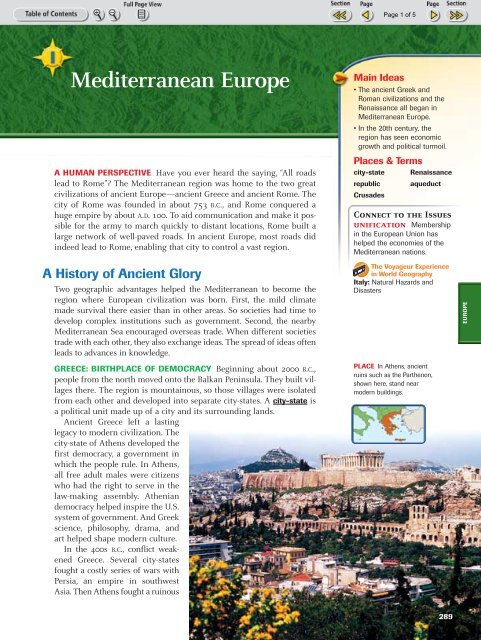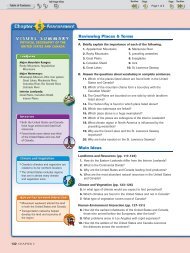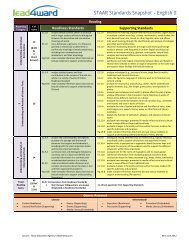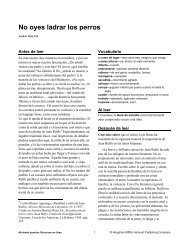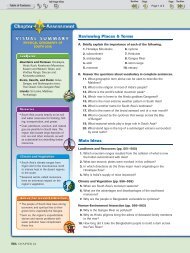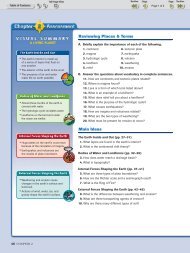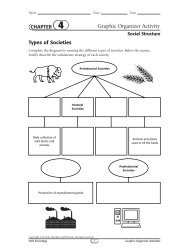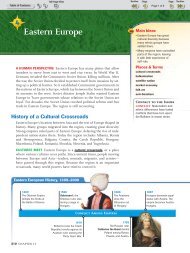File chapter 13 section 1 mediterranean europe.pdf - Teacher
File chapter 13 section 1 mediterranean europe.pdf - Teacher
File chapter 13 section 1 mediterranean europe.pdf - Teacher
Create successful ePaper yourself
Turn your PDF publications into a flip-book with our unique Google optimized e-Paper software.
289-293-Chapter<strong>13</strong> 10/16/02 10:53 AM Page 289<br />
Mediterranean Europe<br />
A HUMAN PERSPECTIVE Have you ever heard the saying, “All roads<br />
lead to Rome”? The Mediterranean region was home to the two great<br />
civilizations of ancient Europe—ancient Greece and ancient Rome. The<br />
city of Rome was founded in about 753 B.C., and Rome conquered a<br />
huge empire by about A.D. 100. To aid communication and make it possible<br />
for the army to march quickly to distant locations, Rome built a<br />
large network of well-paved roads. In ancient Europe, most roads did<br />
indeed lead to Rome, enabling that city to control a vast region.<br />
A History of Ancient Glory<br />
Two geographic advantages helped the Mediterranean to become the<br />
region where European civilization was born. First, the mild climate<br />
made survival there easier than in other areas. So societies had time to<br />
develop complex institutions such as government. Second, the nearby<br />
Mediterranean Sea encouraged overseas trade. When different societies<br />
trade with each other, they also exchange ideas. The spread of ideas often<br />
leads to advances in knowledge.<br />
GREECE: BIRTHPLACE OF DEMOCRACY Beginning about 2000 B.C.,<br />
people from the north moved onto the Balkan Peninsula. They built villages<br />
there. The region is mountainous, so those villages were isolated<br />
from each other and developed into separate city-states. A city-state is<br />
a political unit made up of a city and its surrounding lands.<br />
Ancient Greece left a lasting<br />
legacy to modern civilization. The<br />
city-state of Athens developed the<br />
first democracy, a government in<br />
which the people rule. In Athens,<br />
all free adult males were citizens<br />
who had the right to serve in the<br />
law-making assembly. Athenian<br />
democracy helped inspire the U.S.<br />
system of government. And Greek<br />
science, philosophy, drama, and<br />
art helped shape modern culture.<br />
In the 400s B.C., conflict weakened<br />
Greece. Several city-states<br />
fought a costly series of wars with<br />
Persia, an empire in southwest<br />
Asia. Then Athens fought a ruinous<br />
Main Ideas<br />
• The ancient Greek and<br />
Roman civilizations and the<br />
Renaissance all began in<br />
Mediterranean Europe.<br />
• In the 20th century, the<br />
region has seen economic<br />
growth and political turmoil.<br />
Places & Terms<br />
city-state Renaissance<br />
republic<br />
Crusades<br />
aqueduct<br />
Connect to the Issues<br />
unification Membership<br />
in the European Union has<br />
helped the economies of the<br />
Mediterranean nations.<br />
The Voyageur Experience<br />
in World Geography<br />
Italy: Natural Hazards and<br />
Disasters<br />
PLACE In Athens, ancient<br />
ruins such as the Parthenon,<br />
shown here, stand near<br />
modern buildings.<br />
EUROPE<br />
289
289-293-Chapter<strong>13</strong> 10/16/02 10:53 AM Page 290<br />
Cultural Legacy of the Roman Empire<br />
50 N<br />
North<br />
Sea<br />
Christian areas around A.D. 500<br />
Romance language spoken, present-day<br />
40°N<br />
ATLANTIC<br />
OCEAN<br />
Rhine<br />
R.<br />
Boundary of Roman Empire A.D. 395<br />
Rome<br />
Danube<br />
R.<br />
Black Sea<br />
30°N<br />
Mediterranean Sea<br />
20°N<br />
0<br />
500 1,000 miles<br />
0 500 1,000 kilometers<br />
Azimuthal Equidistant Projection<br />
N<br />
E<br />
S<br />
10°W 0° 10°E 20°E 30°E 40°E 50°E<br />
W<br />
SKILLBUILDER: Interpreting Maps<br />
REGION Which waterways formed part of the northern boundary of the Roman Empire?<br />
MOVEMENT Which Roman cultural influence was more widespread, Christianity or<br />
Romance languages?<br />
war with Sparta, a rival Greek city-state. Finally, in 338 B.C., Macedonia (a<br />
kingdom to the north) conquered Greece. Beginning in 336 B.C., the<br />
Macedonian general Alexander the Great conquered Persia and part of<br />
India. His empire spread Greek culture but broke apart after his death.<br />
THE ROMAN EMPIRE As Greece lost power, a state to the west was rising.<br />
That state, Rome, ruled most of the Italian Peninsula by 275 B.C.At<br />
the time, Rome was a republic, a government in which citizens elect representatives<br />
to rule in their name.<br />
The Roman Empire grew by conquering territory overseas, including<br />
the Iberian and Balkan peninsulas. At home in Italy, unrest over inequalities<br />
led to decades of turmoil that caused Romans to seek strong leaders.<br />
Rome began to be ruled by an emperor, ending the republic.<br />
One of Rome’s overseas territories was Palestine, the place where<br />
Jesus was born. Christianity spread from there across the empire, and<br />
by the late 300s, Christianity was Rome’s official religion.<br />
By A.D. 395, the empire was too big for a single government, so it split<br />
into a western and an eastern half. The Western Roman Empire grew<br />
weak, in part because of German invaders from the north, and fell in<br />
A.D. 476. The Eastern Roman Empire lasted nearly 1,000 years longer.<br />
Background<br />
The Roman republic<br />
was a model for<br />
modern governments<br />
such as<br />
those of France<br />
and the United<br />
States.<br />
Moving Toward Modern Times<br />
After 476, the three Mediterranean peninsulas had very different histories.<br />
The Balkan Peninsula stayed part of the Eastern Roman Empire<br />
290 CHAPTER <strong>13</strong>
289-293-Chapter<strong>13</strong> 10/16/02 10:53 AM Page 291<br />
Background<br />
The Renaissance<br />
shaped modern<br />
life by stressing<br />
classical culture,<br />
material comfort,<br />
and the value of<br />
individuals.<br />
(also called the Byzantine Empire) for nearly 1,000 years. Beginning in<br />
the <strong>13</strong>00s, Italy saw the birth of the Renaissance, and in the 1400s,<br />
Portugal and Spain launched the Age of Exploration.<br />
ITALIAN CITY-STATES The invaders who overran the Italian Peninsula<br />
had no tradition of strong central government. Italy eventually became<br />
divided into many small states and remained so for centuries.<br />
In 1096, European Christians launched the Crusades, a series of wars<br />
to take Palestine from the Muslims. Italians earned large profits by supplying<br />
the ships that carried Crusaders to the Middle East. Italian cities<br />
such as Florence and Venice became rich from banking and foreign trade.<br />
This wealth helped them grow into powerful city-states.<br />
The Renaissance, which began in the Italian city-states, was a time of<br />
renewed interest in learning and the arts that lasted from the 14th<br />
through 16th centuries. It was inspired by classical art and writings.<br />
Renaissance ideas spread north to the rest of Europe.<br />
But the wealth of Italy did not protect it from disease.<br />
In <strong>13</strong>47, the bubonic plague reached Italy from Asia and<br />
in time killed millions of Europeans. (See pages 294–295.)<br />
SPAIN’S EMPIRE In the 700s, Muslims from North<br />
Africa conquered the Iberian Peninsula. Muslims controlled<br />
parts of the Iberian Peninsula for more than<br />
700 years. Spain’s Catholic rulers, Ferdinand and<br />
Isabella, retook Spain from the Muslims in 1492.<br />
Also in 1492, Queen Isabella paid for Christopher<br />
Columbus’s first voyage. Portugal had already sent out<br />
many voyages of exploration. Both Spain and Portugal<br />
established colonies in the Americas and elsewhere.<br />
Their empires spread Catholicism and the Spanish and<br />
Portuguese languages throughout the world.<br />
REGION Italian<br />
Renaissance paint–<br />
ings often show the<br />
Virgin Mary and baby<br />
Jesus. Muslim art,<br />
like the Spanish wall<br />
design below (bottom),<br />
often uses calligraphy<br />
to praise God.<br />
A. Answer Both<br />
spread religion<br />
and language.<br />
Making<br />
Comparisons<br />
What is similar<br />
about the cultural<br />
legacies left by<br />
the Roman and<br />
Spanish empires?<br />
A Rich Cultural Legacy<br />
Mediterranean Europe’s history shaped its culture by<br />
determining where languages are spoken and where<br />
religions are practiced today. And the people of the<br />
region take pride in the artistic legacy of the past.<br />
ROME’S CULTURAL LEGACY Unlike many areas of<br />
Europe that Rome conquered, Greece retained its own<br />
language. Greek was, in fact, the official language of the<br />
Byzantine Empire. In contrast, Portuguese, Spanish, and<br />
Italian are Romance languages that evolved from Latin,<br />
the language of Rome.<br />
The two halves of the Roman Empire also developed<br />
different forms of Christianity. The majority religion in<br />
Greece today is Eastern Orthodox Christianity. Roman<br />
Catholicism is strong in Italy, Spain, and Portugal.<br />
CENTURIES OF ART This region shows many signs of<br />
its past civilizations. Greece and Italy have ancient<br />
ruins, such as the Parthenon, that reveal what classical<br />
The Virgin and Child Surrounded by Five Angels,<br />
Sandro Botticelli<br />
Alhambra Palace, Granada, Spain<br />
Mediterranean Europe 291
289-293-Chapter<strong>13</strong> 10/16/02 10:53 AM Page 292<br />
architecture was like. Spain has Roman aqueducts, structures that carried<br />
water for long distances, and Muslim mosques, places of worship.<br />
The region also has a long artistic legacy, which includes classical statues,<br />
Renaissance painting and sculpture, and modern art produced by<br />
such artists as Pablo Picasso of Spain. The pictures on page 291 contrast<br />
Renaissance Italian art with Muslim Spanish art.<br />
Economic Activity*<br />
10%<br />
31%<br />
24%<br />
12%<br />
27%<br />
8%<br />
24%<br />
Greece<br />
1952 1995<br />
39%<br />
Italy<br />
1952 1995<br />
36%<br />
Trade<br />
35%<br />
25%<br />
29%<br />
Industry<br />
Portugal<br />
1952 1995<br />
51%<br />
52%<br />
47%<br />
Agriculture<br />
Other<br />
14%<br />
3%<br />
14%<br />
4%<br />
16%<br />
21%<br />
26%<br />
19%<br />
33%<br />
SOURCE: United Nations Statistical Yearbooks, 1955, 1997<br />
NOTES: Industry includes mining and construction;<br />
other includes government, utilities, transportation,<br />
and service industries.<br />
* as percentage of GDP<br />
SKILLBUILDER: Interpreting Graphs<br />
SEEING PATTERNS From 1952<br />
to 1995, which economic activities increased<br />
and which decreased?<br />
MAKING INFERENCES Why do you<br />
think the category “other” changed so<br />
significantly? Give possible reasons.<br />
Economic Change<br />
Because of the Mediterranean region’s sunny climate and historic sites,<br />
tourism has long been a large part of its economy. In other ways, the economy<br />
has been changing rapidly since World War II.<br />
AGRICULTURE TO INDUSTRY In general, the<br />
Mediterranean nations are less industrial than those<br />
of Northern and Western Europe. For centuries, the<br />
region’s economy was based on fishing and agriculture.<br />
Fishing remains important, and olives, grapes,<br />
citrus, and wheat are still major agricultural crops.<br />
But in the late 20th century, the region’s economy<br />
grew and changed. Today, manufacturing is increasing.<br />
The making of textiles is Portugal’s biggest<br />
industry. Spain is a leading maker of automobiles,<br />
and Italy is a major producer of clothing and shoes.<br />
Service industries, such as banking, also make up a<br />
much larger part of the economy than before.<br />
In the 1980s, Greece, Portugal, and Spain joined<br />
the European Union (EU). This aided growth by promoting<br />
trade with other EU nations and by making<br />
financial aid from the EU available.<br />
ECONOMIC PROBLEMS The region still faces economic<br />
challenges. For example, Italy’s northern<br />
region is much more developed than its southern<br />
half. The reasons for this include the following:<br />
• The north is closer to other industrial countries of<br />
Europe, such as Germany and France.<br />
• The south has poorer transportation systems.<br />
• The government tried to promote growth in the<br />
south but made bad choices. It started industries<br />
that did not benefit the local people.<br />
Another problem is that the entire Mediterranean<br />
region is poor in energy resources and relies heavily<br />
on imported petroleum. This makes the region vulnerable<br />
because trade problems or wars could halt oil<br />
supplies and prevent industries from functioning.<br />
Modern Mediterranean Life<br />
Mediterranean Europe saw political turmoil in the<br />
20th century. Two dictators, Benito Mussolini in Italy<br />
Background<br />
The EU is an<br />
economic and<br />
political alliance<br />
of 15 nations.<br />
Italy was one<br />
of the founding<br />
members.<br />
292 CHAPTER <strong>13</strong>
289-293-Chapter<strong>13</strong> 10/16/02 10:53 AM Page 293<br />
and Francisco Franco in Spain,<br />
ruled for long periods. After Franco<br />
died in 1975, Spain set up a constitutional<br />
government. After World<br />
War II, Italy became a republic but<br />
has had dozens of governments<br />
since then. Greece has also experienced<br />
political instability.<br />
Using the Atlas<br />
Locate the<br />
Basque language<br />
on the map on<br />
page 267. What<br />
other country<br />
besides Spain has<br />
Basque speakers?<br />
B. Answer France<br />
THE BASQUES Spain has had an<br />
ongoing conflict with a minority<br />
group. The Basque people live in<br />
the western foothills of the<br />
Pyrenees. Their language is the<br />
only pre-Roman language still spoken<br />
in southwestern Europe. In the late 1970s, Spain granted the Basque<br />
region self-rule. But some Basques want complete independence and<br />
have used violence to fight for it. The conflict remains unresolved.<br />
CITY GROWTH The transition from agriculture to manufacturing<br />
and service industries has encouraged people to move from the<br />
country to the city. Urban growth has created housing shortages,<br />
pollution, and traffic jams. The people of Mediterranean Europe<br />
want to preserve their historic cities, so they are trying to solve these<br />
problems. For example, Athens is expanding its subway system to<br />
reduce traffic and pollution.<br />
Despite their problems, Mediterranean cities give intriguing insight<br />
into the past. In Rome and Athens, classical ruins stand near modern<br />
buildings. Florence has glorious works of Renaissance art. Granada,<br />
Spain, has Catholic cathedrals and a Muslim palace. In Section 2, you<br />
will read about Western Europe, a region that also has a rich history.<br />
PLACE Pamplona,<br />
Spain, holds a festival<br />
in which young men<br />
run through the streets<br />
before a herd of<br />
stampeding bulls.<br />
What might this<br />
activity show about<br />
Spanish culture?<br />
EUROPE<br />
Places & Terms<br />
Identify these terms and<br />
explain their importance<br />
in the region’s history or<br />
culture.<br />
• city-state<br />
• republic<br />
• Crusades<br />
• Renaissance<br />
• aqueduct<br />
Taking Notes<br />
REGION Review the notes you<br />
took for this <strong>section</strong>.<br />
History<br />
Economics<br />
Mediterranean Europe<br />
Culture<br />
Modern Life<br />
• What are the two ancient<br />
civilizations of this region?<br />
• What type of movement is the<br />
result of recent economic change?<br />
Main Ideas<br />
a. How was the Renaissance<br />
an example of the<br />
movement of ideas?<br />
b. What is Rome’s cultural<br />
legacy in Mediterranean<br />
Europe today?<br />
c. How has Mediterranean<br />
Europe’s economy<br />
changed since World<br />
War II?<br />
Geographic Thinking<br />
Identifying and Solving<br />
Problems What might help<br />
preserve the historic cities of<br />
Mediterranean Europe?<br />
Think about:<br />
• how to provide housing<br />
and reduce both pollution<br />
and traffic<br />
RESEARCH LINKS<br />
CLASSZONE.COM<br />
ASKING GEOGRAPHIC QUESTIONS Review the paragraph about the Crusades on page 291. Write<br />
three to five geographic questions about the Crusades, such as "Why did many Crusaders purchase<br />
supplies for their ships in Italy?" Do research to answer as many of your questions as possible. Then<br />
create a set of quiz show questions and answers.<br />
Mediterranean Europe 293


